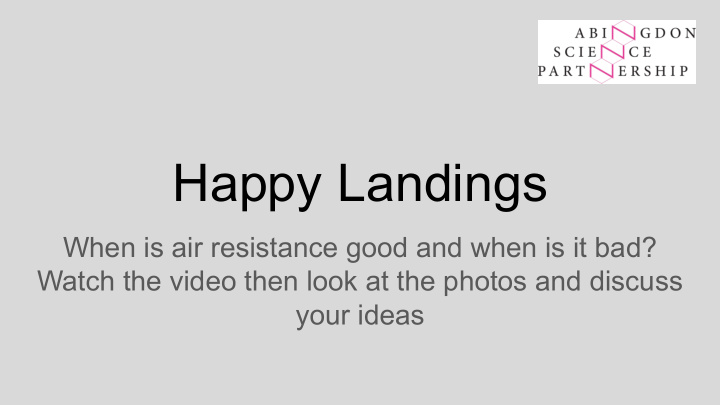



Happy Landings When is air resistance good and when is it bad? Watch the video then look at the photos and discuss your ideas
What IS air resistance? This guy can explain it! https://www.youtube.com/watch?v=O-KYLXp2MG4 (3:58) If you have time, watch Brian Cox doing this REALLY cool experiment at NASA: https://www.youtube.com/watch?v=E43-CfukEgs (4:41)
These are all things that need to move very fast - they need air resistance to be small. How does each one make air resistance smaller when they are moving through the air? Capsules dropped from Peregrine Falcon drones to plant trees Darts used by vets to tranquilise big animals safely
These are all things that need to move slowly - they need air resistance to be big. How does each one make air resistance bigger when they are moving through the air? Some seeds have parachutes to keep them in the air longer A parachute helps slow down the Bloodhound World Land Speed Record Car so it can stop safely A parachute is needed to land space probes on other planets Kites need the air to push against them to lift off the ground
More things to think about - especially if you like a challenge! What happens to air resistance on an object as it moves faster - does it get bigger or smaller? How does air resistance depend on the area of the moving object - if the area is bigger does it get bigger or smaller? How does air resistance depend on the amount of air or type of gas? If the object was moving in Helium (which is less dense than air) would there be more resistance or less resistance than in air?
Instructions for making the cone: Cut ONE of Choose these lines to which size of fold the cone circle you will into shape cut around Helpful video (3:50min) https://youtu.be/-v864gc_d9M 1. Look at the paper cone pattern and decide, with your partner or in your team, how big you will make your cone and whether you will make it more flat or more pointy (ask your teacher how to make the cone if you are not sure) 2. When you have decided, cut out the circle to the size you want; then cut along one of the straight lines to make a slit - slide the paper from one side of the slit over the other to make your cone and then glue or tape it in place 3. Make a small ball of plasticine, cut four cotton threads, tape one end of each thread to the edge of the cone and squeeze the other end into the ball of plasticine 4. Measure a height to drop the cone from YOU MUST NOT CLIMB ONTO ANYTHING UNLESS AN ADULT HAS GIVEN YOU PERMISSION AND IS LOOKING AFTER YOU WHILE YOU DO IT
Instructions for doing the investigation: 1. Hold the cone by its POINT at the height you measured and get ready to drop it 2. Your partner, or someone in your team, should be ready with a timer 3. Count down, 3-2-1, drop the cone, start the timer and STOP when it hits the floor 4. Write the time in the table on the next page then... 5. TURN THE CONE OVER - stick the plasticine ball inside the pointy end, tuck in all the threads 6. Hold the cone by its EDGE at the height you measured and get ready to drop it 7. Your partner, or someone in your team, should be ready with a timer 8. Count down, 3-2-1, drop the cone, start the timer and STOP when it hits the floor 9. Write the new time in the table below 10. Do the investigation three times to see if you get the same results every time
Recommend
More recommend